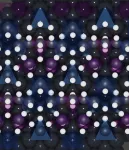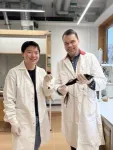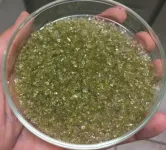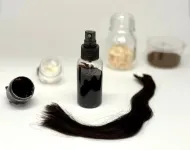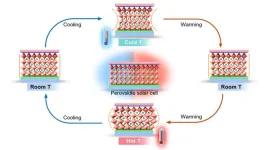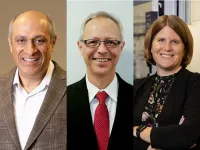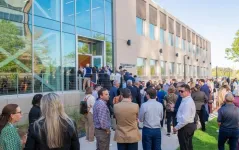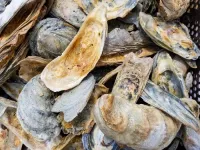(Press-News.org) For nearly two decades, scientists have tried to understand how negatively polarized platinum electrodes corrode, a costly mystery that plagues water electrolyzers, a promising energy technology for making hydrogen, as well as electrochemical sensors using platinum electrodes.
Now, a close collaboration between researchers at the Department of Energy’s SLAC National Accelerator Laboratory and the Leiden University has finally identified the culprit, potentially paving the way for cheaper hydrogen energy production and more reliable electrochemical sensors. The results were published in Nature Materials.
Electrolyzers and many other electrochemical devices often rely on negatively polarized platinum electrodes submerged in an electrolyte – essentially saltwater. That’s an expensive but durable and generally stable option, “but being quite stable doesn't mean it doesn't degrade," says Dimosthenis Sokaras, a senior scientist at Stanford Synchrotron Radiation Lightsource (SSRL) and the SLAC team’s principal investigator.
For most metals, being negatively polarized protects against corrosion. But platinum electrodes can rapidly break down under these conditions, a strange quirk that has puzzled scientists.
"If you take a piece of platinum and you apply a very negative potential, you can dissolve your platinum in a matter of minutes," says Marc Koper, a professor of catalysis and surface chemistry at Leiden University, and the Leiden team's principal investigator.
Two prominent theories had attempted to explain this process. Some scientists thought that sodium ions from the electrolyte solution were to blame. These ions, the thinking went, pushed their way into the platinum’s atomic lattice and formed platinides – platinum atoms lugging around positively-charged sodium ions – that peel away. Others suggested a similar process but pointed the finger at sodium and hydrogen ions – that is, protons – working together to produce platinum hydrides instead.
The research team knew they would need to somehow observe platinum as it was corroding in an electrolyte while making lots of hydrogen. To do so, the team turned to SSRL where researchers have developed high-energy-resolution X-ray spectroscopy techniques that could penetrate the electrolyte and filter out other effects, allowing the researchers to focus in on subtle changes in the platinum electrode in operando, or during operation.
"High-energy-resolution X-ray absorption spectroscopy, for us, was the only technique we could come up with that could sort of deal with the experimental conditions," said SLAC scientist Thom Hersbach.
In addition, the team developed a special “flow cell,” Sokaras said, that could clear hydrogen bubbles that form during the electrode’s operation and interfere with the X-ray experiment.
Using those capabilities together, the team made the first ever observations of platinum actively corroding, recording X-ray spectra from the negatively polarized electrode's surface.
Prior to running the experiment, the researchers had a hunch that hydrides were to blame for the corrosion, but it took several years of analyzing the data before they could prove this hypothesis.
"It just took loads and loads of different iterations of trying to figure out 'how do we accurately capture what's going on?'" Hersbach said.
Using computational models of platinum hydrides and platinides, the researchers simulated the spectra they would expect to see from each structure under the SSRL X-ray beam. Comparing the numerous simulated spectra with the results of their experiment confirmed that only platinum hydride could have produced their results. “By advancing the frontiers of X-ray science, SSRL has developed operando methods that, combined with modern supercomputing, now allow us to tackle decades-old scientific questions,” Sokaras said.
Now, the team's findings can be used to develop solutions for platinum corrosion in electrolyzers and many other electrochemical devices. The project, Koper says, "shows how important in science it is to put a lot of expertise together."
SSRL is a DOE Office of Science user facility.
END
Solving the case of the missing platinum
2025-02-21
ELSE PRESS RELEASES FROM THIS DATE:
Glass fertilizer beads could be a sustained nutrient delivery system
2025-02-21
Agricultural fertilizers are critical for feeding the world’s population, restoring soil fertility and sustaining crops. Excessive and inefficient use of those resources can present an environmental threat, contaminating waterways and generating greenhouse gases such as nitrous oxide. Now, researchers reporting in ACS Agricultural Science & Technology have addressed those challenges with glass fertilizer beads. The beads control nutrient release, and the researchers say they’re environmentally compatible.
“The results show that glass fertilizers can be tailored to plant needs, slowly and sustainably releasing ...
Biobased lignin gels offer sustainable alternative for hair conditioning
2025-02-21
Researchers at Stockholm University have developed a fully biobased hair conditioner using lignin gel emulsions, offering a sustainable and environmentally friendly alternative to conventional haircare products.
Hair conditioners typically contain 20–30 ingredients, many derived from petroleum and oleochemicals, raising concerns about sustainability and environmental impact. A new study published in Science Advances, demonstrates that micellar lignin gels can effectively stabilize emulsions with natural oils, reducing the need for synthetic surfactants and complex stabilizers commonly used in commercial formulations. The research team, led by Mika Sipponen at Stockholm University, ...
Perovskite solar cells: Thermal stresses are the key to long-term stability
2025-02-21
Perovskite solar cells are highly efficient and low cost in production. However, they still lack stability over the decades under real weather conditions. An international research collaboration led by Prof. Antonio Abate has now published a perspective on this topic in the journal Nature Reviews Materials. They explored the effects of multiple thermal cycles on microstructures and interactions between different layers of perovskite solar cells. They conclude that thermal stress is the decisive factor in the degradation of metal-halide perovskites. Based on this, they derive the most promising strategies to increase the long-term stability of perovskite solar cells.
Perovskites ...
University of Houston professors named senior members of the National Academy of Inventors
2025-02-21
University of Houston professors Birol Dindoruk, Megan Robertson and Francisco Robles Hernandez have joined the prestigious list of Senior Members of the National Academy of Inventors.
The University of Houston now has 39 faculty members in the NAI.
“We congratulate these three esteemed colleagues on being named NAI Senior Members,” said Ramanan Krishnamoorti, vice president for energy and innovation at UH. “This recognition is a testament to their dedication, research excellence and pursuit of real-world impact by knowledge and technologies. Their achievements continue to elevate the University as a leader in innovation and entrepreneurship.”
NAI Senior Members ...
Unraveling the mystery of the missing blue whale calves
2025-02-21
Only two blue whale births have ever been recorded in human history, both decades ago. This remains an extraordinary mystery given there used to be hundreds of thousands of blue whales before whaling started — even today blue whales number around 10,000 to 25,000 — and they give birth every two to three years.
Not only are births very stealthy, but calves are also only rarely sighted — far less than would be expected from their pregnancy rates. Calves closely follow their moms and are sighted as mother-calf pairs, but why are so few detected?
A new University ...
UTA partnership boosts biomanufacturing in North Texas
2025-02-21
The University of Texas at Arlington is joining forces with the Texas A&M Engineering Experiment Station (TEES) to operate the new National Center for Therapeutics Manufacturing Satellite Campus at Pegasus Park (NCTM2) in Dallas.
UTA’s Institute of Biomanufacturing and Precision Medicine (IMPRINT) is partnering with TEES on NCTM2, an extension of the National Center for Therapeutics Manufacturing (NCTM) in College Station. The collaboration will expand UTA’s biomanufacturing capabilities and provide NCTM2 with access to financial ...
Kennesaw State researcher earns American Heart Association award for innovative study on heart disease diagnostics
2025-02-21
Kennesaw State University researcher Chen Zhao has earned the 2025 American Heart Association Institutional Research Enhancement Award (AIREA) for his unique research on non-invasive blood flow prediction in cardiovascular disease diagnosis.
The $194,032 award will allow Zhao to continue developing technology aimed at evaluating Fractional Flow Reserve (FFR), a measurement used to diagnose coronary artery disease (CAD). According to the Centers for Disease Control and Prevention, CAD is the leading cause of death in the United States, with an average of 375,000 to ...
Self-imaging of structured light in new dimensions
2025-02-21
Researchers of photonics from Tampere University, Finland, and Kastler-Brossel Laboratory, France, have demonstrated how self-imaging of light, a phenomenon known for nearly two centuries, can be applied to cylindrical systems, facilitating unprecedented control of light’s structure with great potential for advanced optical communication systems. In addition, a new type of space-time duality is explored for powerful analogies bridging different fields of optics.
In 1836, Henry F. Talbot performed an experiment, where ...
Study highlights successes of Virginia’s oyster restoration efforts
2025-02-21
Virginia has made significant investments in the restoration of oyster reefs in the Chesapeake Bay, and now a study led by William & Mary’s Batten School & VIMS suggests those management practices are literally paying off in the Rappahannock River. The study, recently published in the Journal of Environmental Management, was led by Batten School of Coastal & Marine Sciences Ph.D. student Alexandria Marquardt, who presented the results to the Virginia Marine Resources Commission’s (VMRC) Shellfish Management Advisory Committee ...
Optimism can encourage healthy habits
2025-02-21
Do you see the glass as half empty or half full? If you rewind to the start of the COVID-19 pandemic, chances are you experienced some level of pessimism. And who could blame you? With social isolation, health concerns and economic uncertainty, fear and anxiety became a daily reality for many.
A team of researchers from Syracuse University and Michigan State University recently explored the personal characteristics that help people handle prolonged stressors, such as the pandemic. Led by Jeewon Oh, assistant professor of psychology in Syracuse University’s College ...
